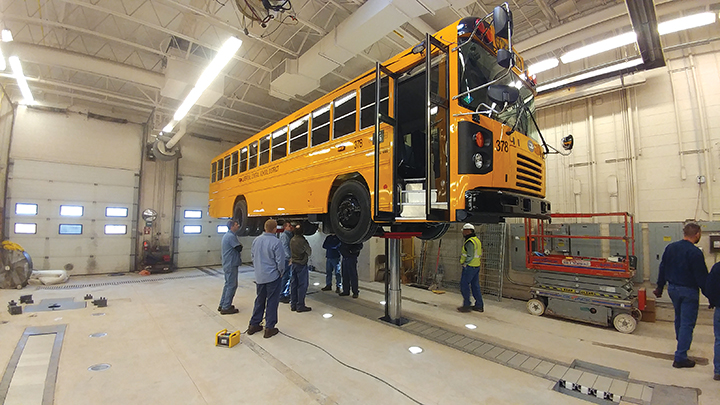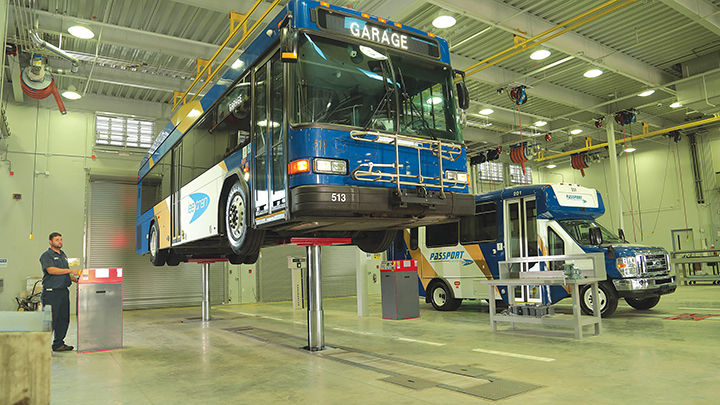
Peter Bowers, technical sales support manager for Stertil-Koni, spoke with BUSRide Maintenance about heavy-duty vehicle lifts – their safe operation, spec’ing the right lift, certification pitfalls, and future developments.
![]()
How should operators go about choosing the “right lift for the job?”
When it comes to choosing heavy-duty vehicle lifts for a maintenance shop, there are three essential considerations: the weight of vehicles to be lifted, including auxiliary equipment; the types of services to be completed; and third-party certification.
From a broader perspective, high-performance lifts capable of lifting more than 16,001 pounds have become an essential tool in today’s busy maintenance shops.
Why? In Stertil-Koni’s case, they are durable, dependable and engineered for safety. Heavy-duty vehicle lifts help speed the maintenance process, dramatically minimize vehicle downtime, and provide a safe environment for the busy technician.
With multiple lift options available, it is important to take a closer look at the most popular types of vehicle lifts, so you can determine which are best suited for your needs.

First, there are Mobile Column Lifts. For shops that plan to go “green,” Stertil-Koni offers the EARTHLIFT, featuring columns made from components that are 98 percent recyclable. These lifts also use bio-degradable fluid and have an active energy retrieval system that delivers 35 percent more lifting cycles at maximum load. Mobile Column Lifts are versatile as they can lift everything from articulated buses, Class 8 trucks, forklifts and agricultural equipment to military, industrial and utility vehicles. Combined in sets – up to 32 columns – the lifting capacity dramatically multiplies to accommodate longer and heavier applications.
An inground option is the piston lift, a telescopic piston-style lift. They deliver wheels-free access to the vehicle. Piston lifts are manufactured in frame or cassette versions. For its part, Stertil-Koni offers a DIAMONDLIFT with lifting capacity of up to 35,000 pounds per piston, with models available in multiple configurations. The latest technologies deliver an optional continuous recess movable lifting unit that recesses below the floor level anywhere within the range of piston travel. This option accommodates low-clearance vehicles. This lift is used for Class 8 trucks, school, coach and transit buses, and heavy-duty trucks such as snow plows, dump trucks, utility vehicles, waste product trucks and many others.
Next you have the inground scissor lift. The benefits of this lift are numerous: wheels-free lifting, ultra-shallow pit design ideal for retrofit into an existing workshop, and a free-standing console for quick service access as well as standard continuous recess for maximum flexibility. Scissor-style lifts engage the vehicle by its axles, offering wheels-free access for all types of repairs. In the example of Stertil-Koni’s ECOLIFT, its electronically synchronized scissor lift can be used to service vehicles like articulated buses, fire and rescue vehicles, multiple-axle trucks, coach, school and transit buses, and more.
Then there is the platform lift, a vertical-rise platform that takes up less room than a parallelogram lift but is similar in that two independent runways are synchronized. Platform lifts are available as surface or flush-mounted; the latter offers a “clear floor” concept eliminating tripping hazards. Special anti-slip plates are available for runways to provide additional skid protection. The platform is best used for preventive maintenance, alignments and inspections. They’re commonly used to service Class 8 trucks, heavy construction and agriculture vehicles and articulated buses.
Another choice is the four-post lift. These offer low drive on height and are ideal for vehicles with low ground clearance. They are easily adjusted to suit the width of the vehicle, which makes them useful for a wide variety of commercial vehicles, including three-wheel forklift trucks, vans, articulated buses, construction trucks, utility vehicles and medium duty trucks up to huge tugs. They’re used primarily for quick preventative maintenance and inspections.
Finally, a two-post lift features above-ground swing arms for lifting vehicles by frame contact. Capacities from Stertil-Koni range from 16,000 pounds to 30,000 pounds. This type of lift is ideal for general maintenance on medium-duty vehicles, notably large pickup trucks and utility vans.

What preliminary purchasing advice can you offer?
When you are ready to purchase a heavy-duty vehicle lift, research is key. It is important to know your fleet, particularly the sizes and weights of the vehicles. You need to know your building where you are going to install the lift, including the foundation, soil condition and the height of the ceilings. It is also a good idea to review lifts that meet your specific fleet’s needs, and if the lift is Automotive Lift Institute (ALI) certified. Stertil-Koni is an active member of ALI, which since its inception in 1945, has been a fiercely independent third-party industry watchdog that actively promotes the safe design, construction, installation, inspection and use of automotive lifting products. Lift purchasers can view a directory of certified lifts on the ALI website: www.autolift.org. I also suggest buyers investigate the manufacturers and lifts they’re interested in. Most of all, become an informed consumer. Purchasing heavy-duty vehicle lifts is a considerable and significant investment. Take time and choose wisely.
Operators know lift certification is important – but what common pitfalls should they look out for?
As I mentioned previously, ALI is the lone nationally recognized standard for vehicle lifts. The ALI gold label is your only guarantee that a lift has been independently proven to meet industry standards. Besides knowing that your lift carries the ALI gold label, technicians should always keep the lift manufacturer operator manual accessible when questions arise. Certification of the lift is significant, but knowledge about the lift is key. Operators should understand how to properly operate the lift and perform inspections of the lift before each shift. They should not use any lift that appears to be damaged or deformed. Also, knowing the vehicle manufacturer’s recommended lifting points is important so that you can always engage the lift at those points. Other common pitfalls can be not setting the lift to mechanical locking, and shifting in the center of gravity of the vehicle if heavy subcomponents are removed.
What preventative maintenance steps do you consider critical for safe lift operation?
Stertil-Koni lifts feature reliable hydraulic technology that require little or minimal maintenance – typically for mobile column lifts, a yearly inspection and an oil change every two years is recommended. Other heavy-duty vehicle lifts have their own maintenance requirements, including inspecting the lifts’ moving parts regularly and regular oil changes using the manufacturer’s required oil type.
What factors (safety, technological, etc.) are driving innovation in lift manufacturing?
Driving Stertil-Koni’s approach is recognizing the push for increased safety in the workplace, the fast-paced transformation of how today’s vehicles are built and advancing new lifting systems technologies to keep pace. Safety in the workshop has always been at the forefront of maintenance facilities operations and in the heavy-duty vehicle lift industry. Stertil-Koni lifts come standard with safe mechanical locking systems, maximum strength high tensile DOMEX steel manufacturing, overload protection and synchronization. Stertil-Koni is also dedicated to embracing green technologies as more companies as well as municipal and state entities are building ecologically sustainable facilities.
What is the biggest development on the horizon related to heavy-duty vehicle lifts?
Fleet managers will have more data, information and feedback from products due to high-tech advances. Feedback will become routine on lifting procedures, preventative maintenance schedules and time lines, as well as allowing technicians to know exactly what the lift’s requirements are.
How will it affect our readers’ operations?
Advances in lift technology will facilitate increased data and deliver more information and real-time data directly to the facility manager, technician and operators. For example, shop mangers could request a feedback report to check on technicians to see if they are following safety precautions and keeping pace with maintaining equipment. Further, increased knowledge will lead to greater assessment of both personnel and lifting systems –thus, contributing to better decision making about fleet operations and practices.
